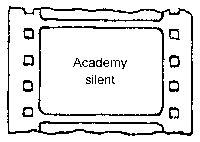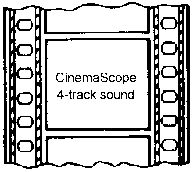
Movie Screen Aspect Ratios
a headache
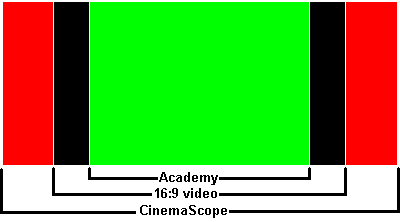
How video will never show what the director wanted to show -
almost just like in the cinema.
INDEX
to this page
Academy
From the very start, the motion picture industry all over the world used now still standard Eastman 35mm perforated film
with a standard projection speed and with what later became the 4:3 Academy frame size
When around 1930 sound was added to the silent screen, the space the sound-track took up on the film strip needed an image reduction to preserve the 1.33:1 aspect ratio. CinemaScope was introduced in 1953 with an aspect ratio of 2.35:1. VistaVision used an aspect ratio of 1.75:1, followed by a spate of wide screen systems running from 1.66:1 to 2:1. Still more systems have been in use, like Cinerama, often with their own aspect ratios.
This rich variety presents problems when showing movies on video screens.
A number of years ago I wrote a letter to the authors of one of those guides to Movies on TV, requesting them to list abbreviations like CS, WS, 4:3, whatever, to indicate the original format. Even though they did list B/W or color, they wrote me back that this would take up too much space and nobody cared, anyway.
But after first the Laser disc was introduced and then DVD, people discovered that those wide screen versions really made a difference, and only then VHS wide screen copies came along.
Alas, confusion still reigns. Maybe this will help you.
Black List
merely a list of copies you'd better stay away from, and for what reasons
The Bottom Line
Some people do not care a stinking fart about all the problems mentioned on this page. When they get a "letterbox" movie on their screens, they zoom in until it fills the screen and effectively crop off: a DoItYourself "reformatted to fit your screen" without even the pan-and-scan option. If you are of that breed, please go away.
Index
| Finding classic movie posters isn't as hard as you may think. From movie memorabilia to celebrity autographed photos, there are literally tons of cinematic treasures to add to your collection. Movie lobby cards, cardboard cut-outs and posters can all be found with a simple movie search. |
Video screens
The standard television aspect ratio is 4:3; the same for computer monitors.
Since then
wide screentelevision has been introduced, aspect ratio 16:9.
On there, different movie screens look like this:

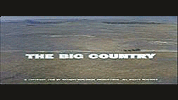

Video wide-screen, squeezed —
letter-boxTechnirama — Video wide-screen, cropped
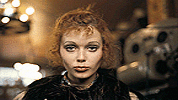

Sylvia Kristel, stretched and Academy masked
the choice seems easy, but is it yours?
The Bottom of Hell
There may be more examples of this, but the absolute worst I ever saw was a copy of
J. Lee Thompson's The Passage
The movie was shot in a CinemaScope aspect ratio in Technovision
It was then cut down for size to Academy 4:3 format which is now available on DVD in 16:9 widescreen format
Obviously, they took a VHDs Academy copy and cut off top and bottom—and Presto!
There may be more examples around; the film can't even be understood and as for sharpness: UGH!
Index
Sound
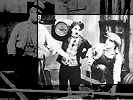
Behind the Screen, 1916
When you add a sound-track to a silent movie, as Chaplin did for The Gold Rush, you have to reduce the film frame by frame with an optical printer (essentially, just a camera hooked up to a projector) to preserve the screen aspect ratio; like Chaplin did. Most didn't bother. It's much cheaper to run the negative through a contact printer and just blank out the part now occupied by the soundtrack. Which explains why the framing of those old movies often looks so weird; then, in projection, you also lose part of the top and bottom of the image and it's cropped much too close and off-center. On a video screen this gets even worse.
| Correct projection speed. When motion pictures went for sound, and thus necessarily for a standardized projection speed, they took the average projector speed the operators used in practice, which was around 24 frames per second. Before then, cameras and projectors were often hand-cranked. A "silent speed" of 16 F.P.S. later, with the introduction of super-8, became 18 F.P.S.. A "correct projection speed" video print of a silent movie may even be at too low a speed. Nowadays non-NTSC movies are often shot at 25 F.P.S., which in Europe is the 50Hz television standard. |
Optical to Digital When optical sound-tracks are transferred to digital audio, the signal-to-noise ratio of the original is often greatly boosted, along with an extension of the treble and bass response: Enhanced. Not necessarily an improvement, as the originals have been mixed with the technical limitations in mind. Then, for the living room there are practical limitations (such as neighbors) to the maximum volume. This is like colorization, remember? - nobody needed it. | |||
| "Enhanced" for widescreen It's getting quite usual to get a CinemaScope original cropped off to 16:9. Not so bad (but it takes some getting used to) is getting a CinemaScope movie compressed so it will, Procrustes-like, fit the 16:9 screen. Doesn't anybody take the trouble to watch those copies? |
PAL-NTSC-HDTV In Europe most television is PAL standard; in Japan and the Americas NTSC. HDTV just isn't around much yet and may never really make it. Newer PAL television sets will handle both PAL and NTSC; not the other way around. Material transferred from PAL to NTSC often is out of synch. Just make sure the DVD player you buy is "all region". | |||
| F.P.S. versus Mains frequency NTSC, mainly in use where there's a 60 Hertz power system, shows 30 F.P.S. (interlaced), with films at 24 F.P.S. PAL, at 50Hz, shows them at 25 F.P.S. Nobody has ever been able to explain to me why, then, you can use NTSC with a 50Hz, and PAL with 60Hz power supply. Works just fine. |
Surround Sound Another terrible mix-up. If you have a surround amplifier, just don't trust the information on the box. Often you'll have the agreeable surprise of getting a stereo copy, or better, and it's not mentioned at all. Best thing to do is try it out by cycling through the possibilities on your amplifier. |
Index
Flicker
Many old movies show a pronounced flicker; that is to say that the image keeps getting lighter and darker. While the very movies were often called 'flickers' in the old days, this was not because the movies flickered. The projection flickered, yes, because in those days the butterfly-shaped projection
shutteralternated at a rate that was discernible to the human eye. But the flicker you see in those old copies has been caused by duping, copying, the film time and time again, so that minute density differences tended to build up until you could see them. Around 2000, the Technical University of Delft, Holland, wrote software to get rid of this artifact in digital copies. As the Dutch would say,
verder geen geflikker [bugger off].
There's a nasty habit to fake "old footage" by introducing artificial flicker
along with, sadly, scratches and dust; all these form a regular pattern which keeps repeating itself
Can't help myself from mentioning here that horrible cliché of showing scenes in the past
with desaturated color - as if people way back then had no color vision
Index

Fred Waller's Cinerama started the wide-screen craze.
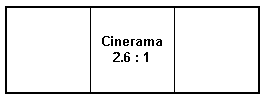
He used 3 specially built 35mm cameras side by side.
The screen was curved so deeply that the actual aspect ratio changed with your position in the theater.
Ultra Panavision used 65mm negative with an anamorphic lens (compression 1.25:1), resulting in 2.8:1.
It's impossible to translate the Cinerama experience to the living room.
Index

The granny of all anamorphic movie systems, devised by Henri Chrétien;
introduced in 1953 by 20th Century Fox with The Robe ("You See It Without Glasses!")
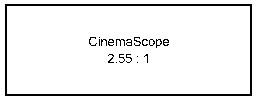
lenses by Bausch and Lomb - compression was 1 : 2.
CinemaScope was projected on a slightly curved screen (which hardly any theater does any more) for two reasons:
— 1. It reminded you, be it ever so slightly and hope is cheap, of Cinerama;
— 2. It helped to keep the screen in focus, making rather clever use of projection lens limitations.
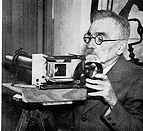
French Professor Henri Chrétien with his anamorphic gadget (originally designed to give army tank personnel a better view out).
The Hubble space telescope is partially based on another idea of Chrétien's.
The device had been described as early as 1898 by Ernest Abbe, founder of the Zeiss works in Germany.
There is an outrageous number of brand-names out there, all based on the same principle.
Holland's Old Delft used a prism system Delrama, later used on VistaVision cameras for Technirama.
Techniscope used half of the negative and "squeezed" it during blow-up to full frame.
These days, it's very often Panavision, wide screen or not.
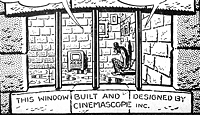
as seen by Bill Elder
CinemaScope used 4 magnetic sound tracks. To make room for those, the Academy frame was narrowed.
At the same time, original silent Academy frame height was restored.
In video terms, this format is called
letterboxed.
Index
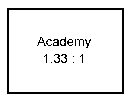
VISTAVISION and wide screen
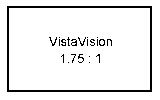
In VistaVision the negative ran through the camera horizontally
resulting in a twice as large negative (not quite still photography 35mm size, using Nikon lenses)
This closely confirms to the
16:9wide-screen video screens.
Technirama used the same system with an anamorphic prism (compression 1.5:1)
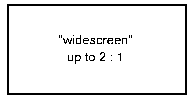
In the beginning cheapskate producers went for this to get a wide screen effect on regular 35mm, but eventually all exhibitors followed suit. Photography was on regular 35mm Academy, then top and bottom of the picture were cropped in projection. Ratios changed from 1.66:1 through 1.85:1 to full 2:1. Just try to compose a decent shot with no idea how it will be cropped. Sometimes, marks in the viewfinder indicated what would be shown; but no exhibitor could check if these had actually been used (and there were no such hairlines in the projector, anyway). Old pre-widescreen movies were projected in the new format, regardless. Often, it already was too much to even ask not to show the line separating the frames, so you got to see any which part of the frame. In movies produced that way, it's quite usual to see microphones dangling up there; and when you look at the film strip, the translated sub-titles run about in the middle of the screen. This procedure managed to waste 25% of negative and positive film stock. There have been efforts to change the pull-down from 4 to 3 perforations but they never worked out.
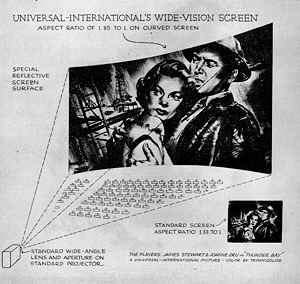
But the operator may show you this:


and the waste!

Some web sites call this "super 35mm", describing the procedure as if the negative was actually masked off. Nobody ever took that trouble; why should they? Then, they go on to tell you that for television release this masked-off, and thus irrevocably lost, portion somehow has been restored magically. Nonsense, of course. It was there all the time. What's really called super 35mm is where they shoot full frame (for TV-release) and crop off a 'Scope frame for theater release. Who knows, they may even blow this up to 70mm? Essentially, it's just a regular Techniscope movie. If I were a cameraman, I'd hate this. It's just a plain schlock way to work. |
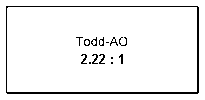
the first 70mm 6-track sound system
the poor man's Cinerama
Todd-AO films were shot on 65mm film and reduced to regular CinemaScope size for second release.
70mm films have since long been shot on 35mm with an anamorphic lens and blown-up to 70mm for first release.
Index
Other Formats
Apart from 35mm film, a number of other formats have been in use, ranging from 8mm to Imax.

The term "3 dimensional" has degenerated completely in the computer age
where it has come to mean just regular changing perspective while you move the camera - like in any motion picture.
But an anaglyph stereo system is something else again!
Index
Viewing It in Video
| The Crop This does not take the special problems with silent movies in consideration. An image gets cropped off during projection, which is even worse for video which tends to underscan— borders are cropped. A computer monitor tends to overscan, showing black borders around the image. A later development, since the advance of wide-screen tv-sets. Now they pan and scan like they used to do for wide-screen to fit an Academy movie to a wide-screen tv, only vertically! Horrible. Not quite that bad, but bad enough, is cropping the left and right of a CinemaScope-like image to make it fit a 16:9 wide-screen video. At first sight totally incomprehensible is masking left and right of a wide-screen video-release to arrive back at Academy 4:3 ratio; this results in an enlargement out of the full-frame image. But a new original-scan is much more expensive. However that may be, I've met guys who on having a letter-boxed copy to look at, enlarge it until it fits their Academy screen; effectively cutting off left and right. Really. Even worse is how DVD-releases these days cut off top and bottom of the screen, just like in the good old wide-screen days, to make a better fit on the 16:9 tv-screens. Examples: 20th Century Fox did so for Delmer Daves' 1950 Broken Arrow. And much worse, so did the much self-vaunted Kriterion Collection for Carol Reed's The Fallen Idol; and had the temerity to claim that they released it in the original 4:3 Academy format. In fact, I think these are crimes in violation of copyright laws. |
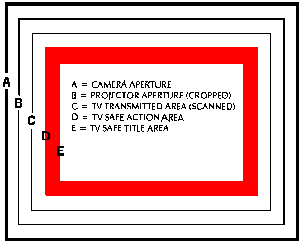
wide screen on a standard 4:3 television screen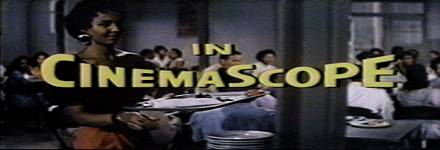 From the trailer of Otto Preminger's Carmen Jones 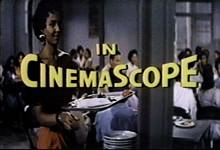 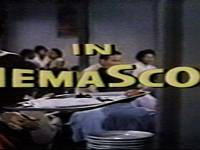 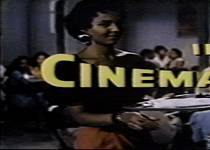 squeezed— cropped — pan and scan |
| Squeezed: the best option, so, nobody uses it. Remember, practically all 'Scope movies have been shot with a squeezedviewfinder. At the railway station in Utrecht, the Netherlands, there used to be a small cinema in a converted train car. No screen wider than Academy fit in there, so they showed all CinemaScope Tom and Jerry cartoons squeezed. In the Luxor of Nijmegen, Holland, they showed all cartoons in the unsqueezed format. I never met anyone else who even noticed. Long after I'd written all this, I finally scored a copy of Saul Bass on Titles, where he shows his title sequences squeezed. Cropped: Mostly just terrible. Pan and scan: The cropping scanner moves over the screen to follow the action. This absolutely ruins the composition and timing of the movie. Warning! What often is called Full Screenactually means cropped- that hateful term Re-formatted to fit your screen. Another problem here is use of the wrong projector mask when converting "unsqueezed" films to video - more of the frame gets cut off (top and bottom) then the cameraman bargained for. |
| Resolution: Screen versus Tube A screen resolution of 1024*768 pixels is good enough to watch movies The optically available resolution of 100 lines/mm still cannot be achieved by motion picture negative stock. Printing results in more loss, and final resolution will be well below 50 lines/mm. A 16x22mm frame of a 35mm movie print does not hold more info than a 1024x768 pixel screen can show. Projecting slides or digital stills is a different matter, and this also does not apply to recent HD movies. |
| It may surprise you that the lenses for all these formats give relatively the same definition. You should not be able to see any difference between 65mm and 8mm, were it not for the fact that the emulsion manufacturers never reached the standards the lens manufacturers had set for themselves. The same happened in still photography, where only around 1990 Eastman-Kodak introduced T-Max, which gave 35mm B/W the same definition you could get on a 4"x5" camera. This still is way below 8"x10", and we're not discussing color, either. Or digital cameras... |
| George Eastman and Kodak The genius of this man becomes even more obvious when you realize his invention of perforated celluloid film not only made movies possible at all, but was so well executed that the world has used this format for well over a century. The first motion picture was shot in 1891 and virtually all cinemas still use film. (The USA probably is the first country to be equipped with digital projectors, in 2006 and 2007.) The word filmeven came to mean any moving picture, no matter if it has been recorded with a different technique. The man also made a bundle. |
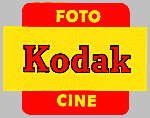 |
| Video terms — Wide Screen: a screen format of 16:9 aspect ratio Wide screen (anamorphic): is used indiscriminately for Ultra Panavision to VistaVision productions. Doesn't mean a thing. — Wide screen (enhanced): ought to mean they use all available memory to record a picture, reintroducing the back borders on showing. But don't count on it. — Letterboxed: This should be safe. It means the full CinemaScope 2.35:1 aspect ratio is, at least, scanned and recorded. But watch it. |
| Remember this: With most types of tv screens, the masked borders will burn in pretty soon and ruin the display. The best way out now, if you really care about movies, is to buy a digital video projector. Prices are coming down; quality is going up. The burn-in problem has gone the way of all flesh with LCD-screens; however, something called "image persistence" remains; it's not a permanent effect, though. While this is no problem when showing movies, it can theoretically be awkward when processing photos. But, a computer screen-saver has become superfluous. Plasma television screens are really notorious for burn-in effects! |
Index
unpaid ad

don't waste your money
on silly advertisements
WARNING
from Region Code Free DVD
"Due to high product defect rates, and unreliability, all the JWIN, Daewoo, Akai, and Coby dvd players are excluded from our warranty and guarantees. All warranty claims are addressed through the manufacturer only. Please do not contact us for warranty service on any of these items."

Where we try to explain about things that make life hard for the projectionist—and for his victims.
The Smallest Show On Earth



Charming British comedy about a couple who inherit a decrepit movie theatre mere yards away from the train tracks. Contains practically all mistakes an operator can make. Margaret Rutherford is the aged ticket seller, Peter Sellers a drunken projectionist. With Virginia McKenna, Bill Travers. 1985, 80 min. Widescreen (Enhanced); Soundtrack: English Dolby Digital mono; biography.
Stanley Donen and Gene Kelly entertainingly tell about some of the problems Hollywood encountered when changing over from silent to sound movies, which amounts to a completely different form of entertainment.
Singing In The Rain (1952)




Other Formats
Apart from 70mm, 65mm and 35mm at least five other formats have been in use
(not even counting 55mm and super 16):
— "Grandeur Screen"
this wide-screen process was developed by 20th Century Fox, but because of the depression there was no money to equip the theaters with 70mm projectors; rather funny, as the standard story would have it that same depression caused the theaters to get wired for sound.
It was used for Raoul Walsh' 1930 The Big Trail, according to George Carpozi's The John Wayne Story (New York 1972).
A word of warning: the DVD-copy on the market has also been cropped to standard Academy size.
— Fantasia
was also produced in a similar double-width format; here it was WWII that prevented its release in wide-screen and stereo sound.
Too bad Walt Disney never re-released it in that format.
— 16mm
the screen aspect ratio of 16mm is exactly that of 35mm Academy, with or without sound track
— 8mm
16mm split lengthways, which resulted in a different aspect ratio, mainly because of the perforation size
— super 8
introduced by Eastman Kodak around 1965 and conforming to the Academy aspect ratio, by using smaller perforations
Fuji had single-8, the same in the projector but in a different camera cartridge
then again, you could buy the stuff on rolls as well to add to the general confusion
— super 16
developed after super 8 for professional use. Never really took off as larger size benefits were too marginal to justify investing in entirely new equipment all down the production line
— 9.5mm
which had a perforation in the middle of the filmstrip between two frames.
— Imax
Uses a 53x53mm negative on 65mm film (the largest width you can hold flat in the aperture). There even is a stereo version.Unless I have mentioned it, don't ask me what aspect ratios all these had, especially with sound-tracks added.
Index
8mm film
Super 8 film
9.5mm film
16mm film
Super 16 film
35mm film
Super 35
70mm film
Academy screen
Cinerama
CinemaScope
cropped
DVD Region
George Eastman
Flicker
F.P.S. frames per second
"Full Screen"
George Eastman
HDTV High definition tv
IMAX
Kodak
Letterbox
NTSC, PAL
Optical sound
Other Formats
PAL, NTSC
pan and scan
Mains power supply frequency
Resolution
Screen Savers
squeezed
Technirama
Sound
Super 8 film
Single 8 film
Techniscope
Terminology in video
Video cropping
Video Screens
Video Terminology
VistaVision
Windowboxeda>
SEARCH this site or the Web

copyright notice
all material on this site, except where noted
copyright © by , curaçao
reproduction in any form for any purpose is prohibited
without prior consent in writing
